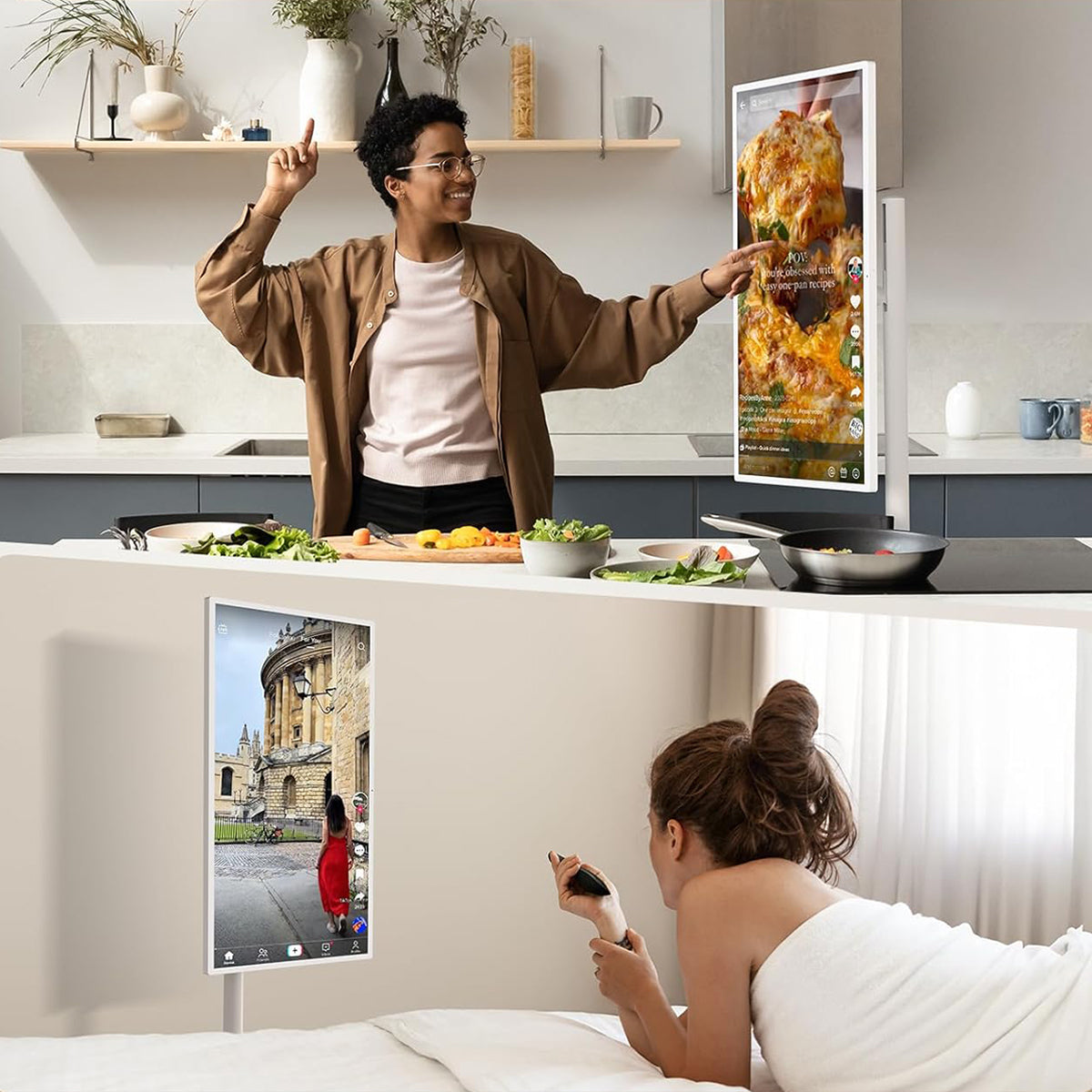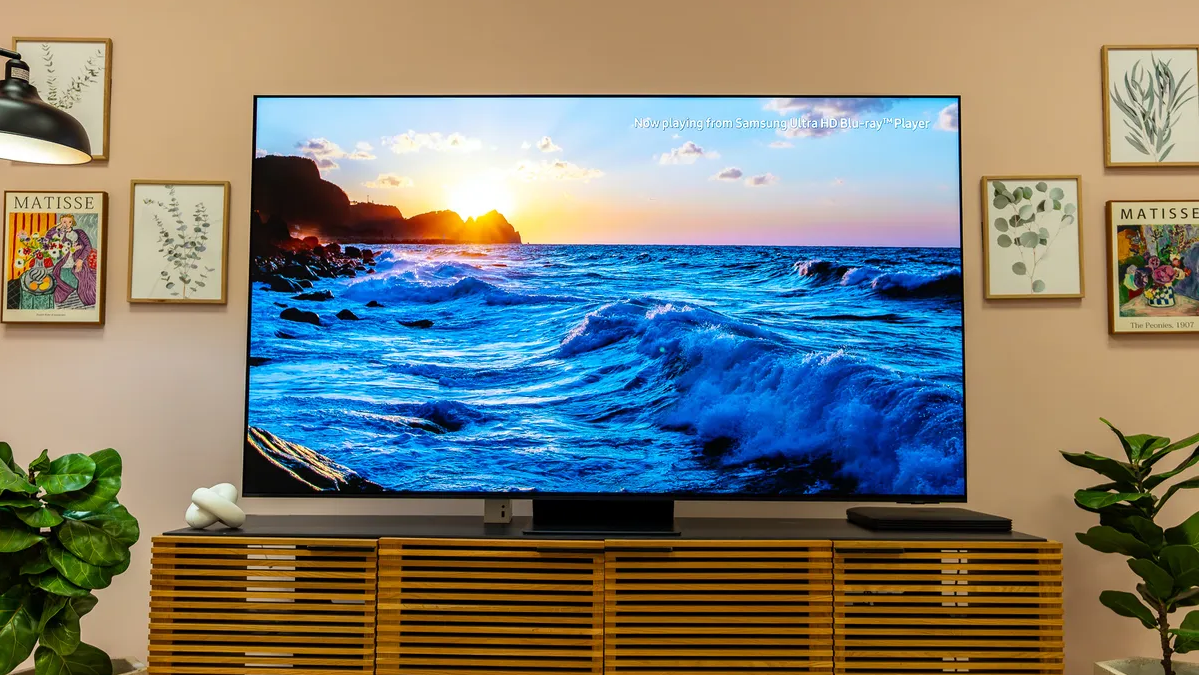Table of Contents
Wireless TV is growing rapidly, changing the way you watch television. We know you were used to traditional television sets, whose tangled wires consumed a lot of space, and satellite dishes had to be adjusted to catch signals to offer a clear picture and audio, but wireless models use a separate “Zero Connect Box” to provide the same on your screen. This technological advancement gives you a clean, minimalist aesthetic, greater flexibility in placement, and a more streamlined entertainment experience. According to Research and Markets, the United States Smart TV market is expected to reach $134.97 billion in 2033 from $54.95 billion in 2024.
Do you want to learn more about wireless TV? Then, this blog will guide on what they are, the popular brands, how to choose, whom to approach, and other details.
What Is a Wireless TV?
A wireless TV receives audio and video signals from a Zero Connect Box, without attaching physical cables. This technology ends the bunch of wires that were previously linked with traditional televisions, like HDMI and power cables.

Working Style
All the wires of your gaming consoles, soundbars, or Blu-ray players are directly connected to the Zero Connect Box, which wirelessly does the magic of transmitting the audio and video data to the TV screen. It simply uses a high-bandwidth, proprietary signal to serve the purpose. Furthermore, no wiring allows the TV to be sleek and thin, with only a power cord that you need to plug into the wall.
Advantages of Wireless TV
Wireless TV offers a cleaner and more minimalistic look as the smart screen can be mounted on a wall without assembling cables, creating a modern aesthetic. Besides, it also offers greater flexibility because you are no longer restricted to staying near the power outlets or cable ports. This layout simplifies installation and makes it easier to revamp your living room.
Wireless TVs of Famous Brands
LG Wireless TV
The LG Signature OLED M series makes LG a trend-setter in the wireless TV market. This range of high-end TVs contains a “Zero Connect Box” that transmits 4K video and audio to the smart screen, allowing an extremely thin OLED panel to be installed on a wall without cables, creating a minimalist and immersive viewing experience. You can place the Zero Connect Box up to thirty feet away, providing drastic flexibility in your room’s layout. LG’s G-series of OLED TVs even offers an elegant design for mounting on the wall, but they depend on traditional connections for their inputs.

Samsung Wireless TV
Samsung has also stepped into the wireless TV arena with a heavy focus on lifestyle and aesthetics. Not all of their televisions are completely wireless; some versions, like the Samsung S95D, use a One Connect Box, containing all the ports and connections. It transmits power and data to the display through a single, thin, and transparent cable. While not completely wireless, it still reduces cable mess, providing a clean look, especially for wall-mounted arrangements.

TCL Wireless TV
Next in line is TCL, popular for selling feature-packed wireless TVs at competitive prices. Some of their high-end versions, specifically in their Mini-LED and QLED lineups, might integrate a Once Connect Box-like system, allowing easy installation. This keeps the main TV panel free from the cable clutter, letting the company concentrate on premium-quality picture technology, like Mini-LED and QLED, merged with a convenient setup.
GFF Wireless Portable TV on Wheels
The GFF Wireless portable TV on wheels is distinct from other wireless variants you see out there. Their TV on wheels is compact and runs on a battery, designed for unbeatable portability. Plus, the wireless TV on wheels proves its versatility in being moved around from room to room, so be it any outdoor event or a presentation, this tablet on wheels will help you ace every project.
Apart from this, the smart screen consists of a built-in battery, a touch screen, and an authentic and certified Android operating system to access applications. Keep in mind, this wireless TV doesn’t just entertain you, but you can use it as a secondary display, which can be flexibly moved around the house.

Sony Wireless TV
Sony, an old leader in TV, is not as focused on wireless connectivity as LG is, but a few of its Bravia models are designed to work seamlessly with your wireless home theater systems. For instance, their televisions might be designed to pair wirelessly with particular soundbars and rear speakers, decreasing the number of cables needed to complete the whole audio setup. The brands lay heavy stress on supreme picture quality, which the powerful XR processor drives with technologies such as OLED and Mini LED.
How to Choose a Wireless TV for Your Home?
To choose a wireless TV, you must look beyond the cables and consider a few factors to ensure it’s the right fit for your home and lifestyle:
Check Wireless Technology and Range
A wireless TV should carry the potential of transmitting audio and video without a physical cable. The transmission is done through a “Zero Connect Box” or a similar external unit. Therefore, we recommend that you check the transmission range. Most brands like Samsung and LG claim to offer a range of up to thirty feet, which is enough for many living rooms. On top of that, see whether the wireless signal is able to pass through walls or furniture without disturbance, as this impacts the box’s placement.

How Is The Display Type?
Despite having no wires, a wireless TV is still a television, where you want good picture quality. Hence, examine the different types of displays. For instance, Organic Light-Emitting Diode (OLED) is famous for perfect blacks and infinite contrast, while QLED and Mini-LED offer outstanding brightness and rich colors, making them ideal for rooms with adequate lighting.

While evaluating, consider the resolution, as 4K is the current standard, with 8K available for a premium, and the refresh rate should be 120 Hz or higher for gamers and sports fans to match and offer you the ultimate viewing experience.
What Connectivity Options Are There?
Wireless TV doesn’t mean that it won’t require cables to operate. You need to make sure that the external Zero Connect Box has a sufficient number of HDMI and USB ports for all your gaming, soundbars, and streaming player devices. Therefore, try to lay your hands on a box that consists of HDMI 2.1 for high-speed gaming and eARC support for exceptional audio passing. And even look at what smart TV platform it can run on. For instance, webOS and Google TV. Plus, purchase the box only if the technology can support all your favorite streaming applications and integrate with your smart home’s ecosystem.
The Wireless TV is on the Rise, Market Analysis
The wireless TV is a segment of the larger smart and connected TV market that has been experiencing drastic growth. The “completely wireless” TV is a comparatively new offering, but the concept of decreasing the cable clutter is a prominent trend driving consumer behavior:

Market Drivers and Growth
One of the primary drivers of the wireless TV market is the increasing demand for elegant, minimalist, visually striking home aesthetics and the desire for greater flexibility in the placement of the device.
In addition, the streaming services and the integration of smart home technologies equally contribute to the surge. Market analysis hints that the overall smart TV market is anticipated to grow more in the coming years because people prefer advanced features, high-resolution displays, and smooth connectivity.
Key Players
LG, with its LG Signature OLED M series, and GFF portable TV on wheels. They have always offered a single-cable solution with the One Connect Box, whereas other brands, such as TCL and Sony concentrated on high-quality displays, smart features, and are now creating designs to reduce cable clutter. The competition is serious, where these brands are working hard for market share through innovations like improved wireless transmission standards and user-friendly controls.
Future Outlook and Trends
The wireless TV market has quite a promising future. The new trends will concentrate on integrating AI for tailoring content recommendations, boosting connectivity with surfacing technologies such as Wi-Fi 6E, and making wireless power transmission a reality.
When the manufacturing prices decrease, this technology is projected to become more accessible to more consumers, making wireless entertainment a standard in home media.
GFF Portable Wireless TV on Wheels
The GFF Portable Wireless TV on Wheels offers you a unique and versatile viewing experience in the following ways:
Portable Design
The GFF model is built with a sturdy stand and wheels, unlike your traditional televisions, letting you move from room to room. This is perfect for those living a flexible lifestyle, so if you want to watch a cooking show in the kitchen, a movie on the patio, or a workout video in the living room, the wireless TV can assist you anytime and anywhere.
No need to worry about the battery as it’s built-in, rechargeable, and provides hours of wireless operation, ending the issue of sitting near the power outlets.

Interactive Touchscreen
The portable television features a large, high-resolution touchscreen, finishing the line between a giant tablet and a TV. The wireless TV on wheels runs on an authentic Android operating system, allowing you access to a wide range of applications from the Google Play Store. You can even rotate the screen between portrait orientations and landscape, to watch films or social media videos, and the built-in camera and microphone, perfect for video calls or remote meetings.
Conclusion
Don’t miss out on GFF’s portable smart TV with Wi-Fi, as the wireless TV is packed with smart features and the ability to move around without managing a bunch of wires. Get a quote now!





